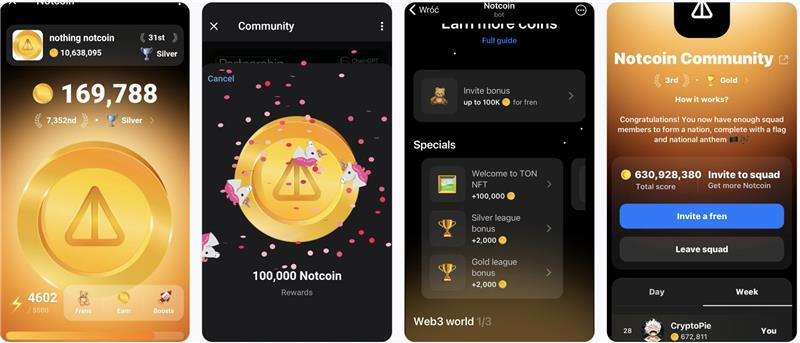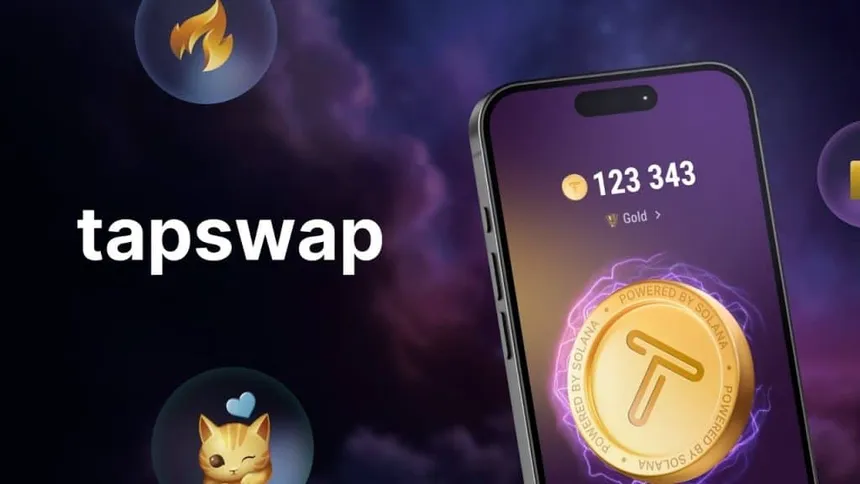
A Beginners Guide to Clicker Games
Tap-to-earn crypto games or clicker games are a growing segment of the gaming industry where players earn cryptocurrency by engaging in simple, tap-based gameplay. These games are designed to provide an easy and accessible way for players to accumulate digital assets, making the process of earning crypto straightforward and enjoyable. The primary purpose of the Tap-to-Earn model is to incentivize user engagement by offering tangible rewards in the form of cryptocurrency.
Understanding Tap-to-Earn
Tap-to-earn crypto games have emerged as a popular way for players to earn digital assets through engaging, straightforward gameplay. The gameplay mechanics are usually simple, involving actions like tapping the screen to achieve certain goals or complete tasks.
This simplicity makes these games accessible to a wide audience, including those who might not be traditional gamers. The core appeal lies in the ability to earn cryptocurrency or other digital rewards by spending just a few minutes playing each day.
The integration with blockchain technology is a crucial aspect of Tap-to-Earn games. Blockchain provides a secure and transparent ledger for recording transactions and ownership of digital assets. This ensures that the rewards earned by players are verifiable and immutable, enhancing trust in the system. Players typically connect their crypto wallets to the game, allowing them to receive and store their earnings directly. This seamless integration with blockchain technology also opens up the possibility for these games to support non-fungible tokens (NFTs), which can represent unique in-game items or assets.
The types of rewards in Tap-to-Earn games can vary. The most common rewards are cryptocurrencies or specific tokens associated with the game. These can be earned by completing tasks, reaching milestones, or participating in daily challenges. In addition to cryptocurrencies, players may also earn in-game assets that hold real-world value. For example, NFTs representing rare items, characters, or skins can be traded or sold on various marketplaces. These in-game assets often enhance the gaming experience, providing both functional benefits and aesthetic enhancements.
Origin and Evolution
Tap-to-earn games have roots in the broader category of casual games, which have been popular since the early days of mobile gaming. Casual games are characterized by their simple mechanics and easy-to-learn interfaces, making them accessible to a wide audience.
Titles like “Flappy Bird” and “Candy Crush” dominated the early 2010s, captivating millions of players with their addictive gameplay and minimal learning curve. The success of these games demonstrated a significant market for engaging, easy-to-play mobile games.
As the gaming industry evolved, so did the mechanisms for monetization. Initially, the primary revenue streams for casual games were in-app purchases and advertising. Players could buy virtual goods or watch ads in exchange for in-game benefits.
However, the introduction of blockchain technology and cryptocurrencies in the late 2010s opened up new possibilities for rewarding players directly with digital assets. This innovation paved the way for the development of crypto games, where players could earn real value instead of just in-game perks.
The transition from casual games to crypto games was influenced by several key factors. First, the rise of blockchain technology provided a secure and transparent way to handle digital transactions and ownership, addressing concerns about fraud and manipulation in online games.
Second, the increasing popularity of cryptocurrencies created a demand for new ways to earn and use digital assets. Game developers saw an opportunity to merge these trends, creating games where players could earn crypto rewards through gameplay.
Inspirations for Tap-to-Earn games come from various sources. The success of early blockchain games like “CryptoKitties,” which allowed players to buy, sell, and breed virtual cats using Ethereum, showcased the potential of integrating digital assets into gaming.
By combining elements of casual gaming with blockchain’s transparency and security, Tap-to-Earn games offer a unique blend of entertainment and financial opportunity.
How Tap-to-Earn Works?
Game Mechanics and User Interaction
Tap-to-earn games operate on straightforward and intuitive mechanics, typically involving simple actions like tapping, swiping, or clicking. These games are designed to be accessible, ensuring that players of all ages and technical expertise can participate.
For example, a Tap-to-Earn game might involve tapping the screen to collect coins or complete tasks that earn points. The simplicity of these actions makes the games engaging and addictive, encouraging repeated play. User interaction is often enhanced by in-game challenges, levels, and achievements that provide a sense of progression and accomplishment.
Reward Generation and Distribution
The core attraction of Tap-to-Earn games is the ability to earn real-world value through gameplay. Rewards are usually in the form of cryptocurrency or valuable in-game assets. Each action or completed task generates a small amount of reward, which accumulates over time.
The distribution of these rewards is typically handled by a backend system that tracks player activity and assigns value based on predefined rules. For instance, completing a level might earn a player a certain amount of a game’s native token, which can be stored in a digital wallet.
Technical Aspects: Blockchain Integration and Smart Contracts
Blockchain technology underpins the entire Tap-to-Earn model, ensuring transparency, security, and verifiability of transactions.
The blockchain records every action that leads to a reward, creating an immutable ledger of player activities and earnings. This integration is crucial for maintaining trust among players, as it guarantees that rewards are fairly distributed and cannot be tampered with.
Smart contracts play a pivotal role in automating reward distribution. These self-executing contracts contain the rules and conditions for earning and distributing rewards.
When a player completes an action that qualifies for a reward, the smart contract automatically triggers the transfer of cryptocurrency or in-game assets to the player’s wallet. This process eliminates the need for intermediaries and reduces the risk of errors or fraud.
Examples of Tap-to-Earn Games
Popular Games Using the Tap-to-Earn Model

- Notcoin: Notcoin is a pioneering tap-to-earn crypto game on the TON blockchain with straightforward and addictive gameplay. Players mine Notcoins by tapping the screen and can earn additional rewards through community activities and events, making it an accessible entry point to tap-to-earn gaming.

- Hamster Kombat: Hamster Kombat features adorable hamsters in combat scenarios where players earn crypto rewards by tapping to perform various actions. Its interactive approach and engaging mechanics have garnered a dedicated player base.

- TapSwap: TapSwap allows players to mine TAPS coins by tapping the screen. Players can upgrade their mining tools to increase earnings over time, offering a straightforward yet rewarding tapping mechanic.
Benefits and Challenges
Advantages for Players and Developers
- Benefits for Players: Tap-to-Earn games offer real cryptocurrency rewards, turning casual gaming into a profitable activity. This attracts a wider audience, including crypto enthusiasts. These games provide a fun, low-risk introduction to digital assets and are accessible to a broad range of players due to their simple mechanics.
- Benefits for Developers: Tap-to-Earn games can attract a large user base by offering real rewards, boosting player retention and engagement. Blockchain integration enhances transparency and security, appealing to tech-savvy players and building trust. Developers can capitalize on the growing interest in cryptocurrencies, positioning their games in a trending market.
Potential Drawbacks and Limitations
- Drawbacks for Players: Tap-to-earn games come with challenges. Cryptocurrency market volatility can cause reward values to fluctuate, affecting earnings. The need for a crypto wallet and basic blockchain knowledge may deter less tech-savvy players. Security is also a concern; players must use secure wallets and platforms to avoid scams and hacks.
- Drawbacks for Developers: Integrating blockchain and cryptocurrency systems can be complex and costly, requiring significant resources and expertise. Regulatory uncertainties add to the challenge, as developers must comply with different legal requirements across jurisdictions, impacting game operations and reward distribution.
Future Prospects and Trends
The future of Tap-to-Earn games looks promising, with continuous advancements in blockchain technology and increasing mainstream acceptance of cryptocurrencies. As technology evolves, we can expect improved security features, enhanced user interfaces, and more seamless integration of cryptocurrency wallets, making these games more accessible and attractive to a broader audience. The development of cross-chain solutions may also enable Tap-to-Earn games to support multiple cryptocurrencies, offering greater flexibility and earning potential for players.
Furthermore, the integration of NFTs (non-fungible tokens) within Tap-to-Earn games is an emerging trend that could provide additional revenue streams and unique gameplay experiences. Players could earn and trade NFTs as part of their gaming experience, adding another layer of engagement and value. The continued growth of the metaverse and virtual worlds could also drive the popularity of Tap-to-Earn games, as players seek new ways to earn and interact within these digital environments.
Conclusion
Tap-to-earn crypto games offer a unique blend of entertainment and financial opportunity, allowing players to earn digital assets through gameplay. With the continuous evolution of blockchain technology, these games are poised for significant growth in the crypto space. Remember, doing your research is crucial before diving into any investment. Stay informed and explore the exciting possibilities with Mudrex Learn blogs, where we guide you on the most exciting developments in the crypto and web3 space.
FAQ Questions
What are Tap-to-Earn crypto games?
Tap-to-Earn crypto games are mobile or web-based games where players earn cryptocurrency rewards through simple, repetitive actions like tapping the screen.
How do players earn rewards in Tap-to-Earn games?
Players earn rewards by completing in-game tasks, achieving milestones, or participating in events that reward them with cryptocurrency or tokens.
What types of rewards can players receive?
Players can receive various rewards, including cryptocurrencies like Bitcoin or Ethereum, game-specific tokens, or NFTs (non-fungible tokens).
Are Tap-to-Earn games profitable for developers?
Yes, these games can be profitable for developers through in-game purchases, advertisements, and transaction fees associated with the cryptocurrency economy within the game.
What are the main challenges facing Tap-to-Earn games?
The main challenges include maintaining user engagement, ensuring game security, handling market volatility of in-game currencies, and navigating regulatory environments.





